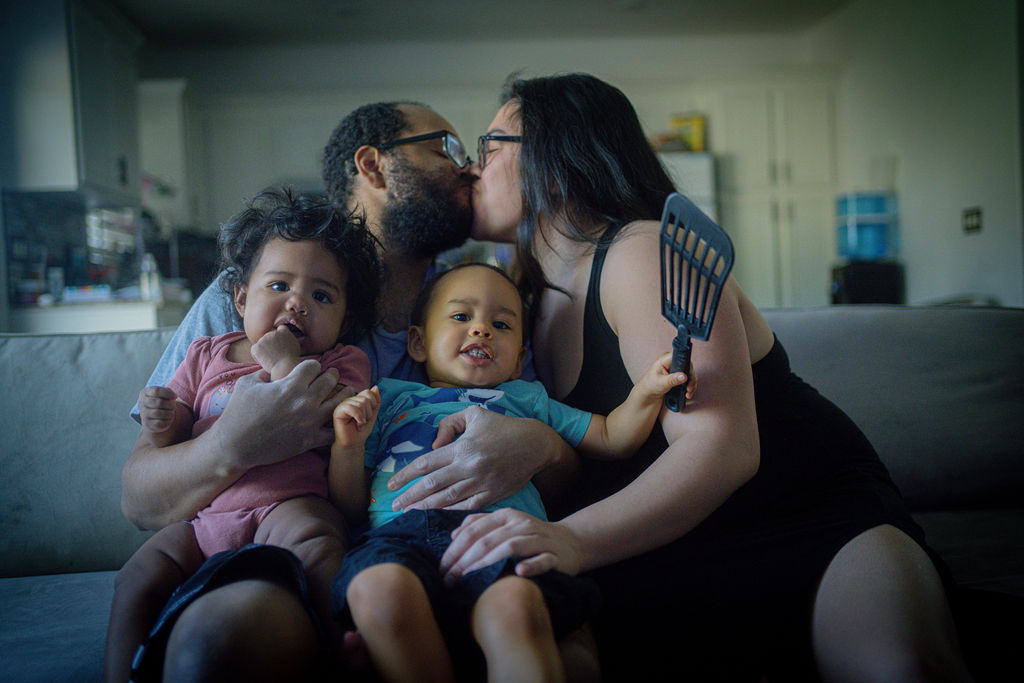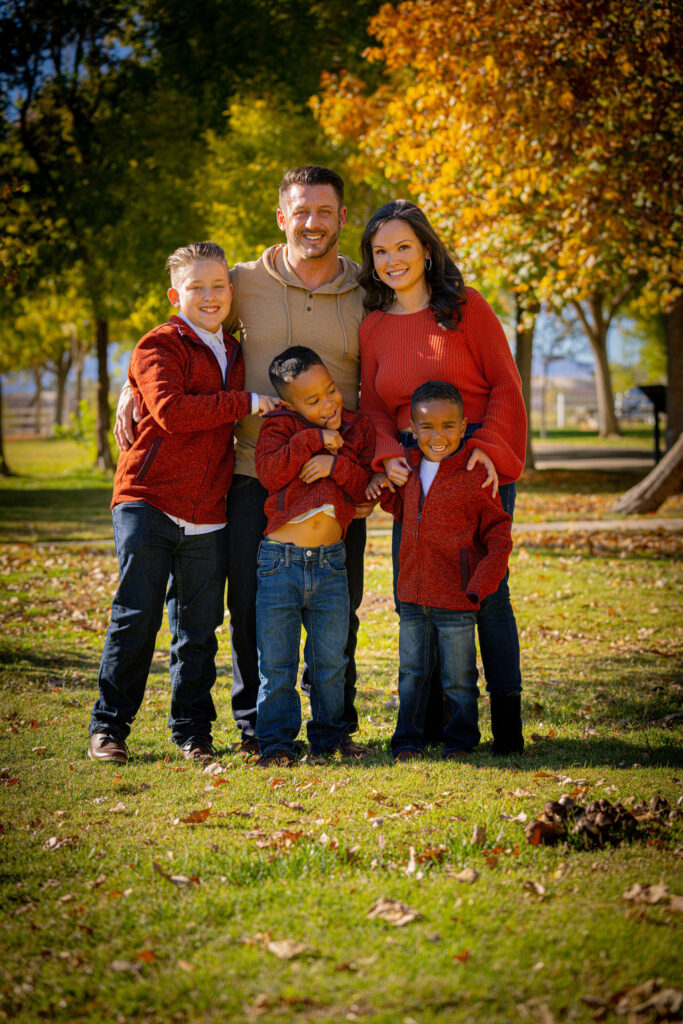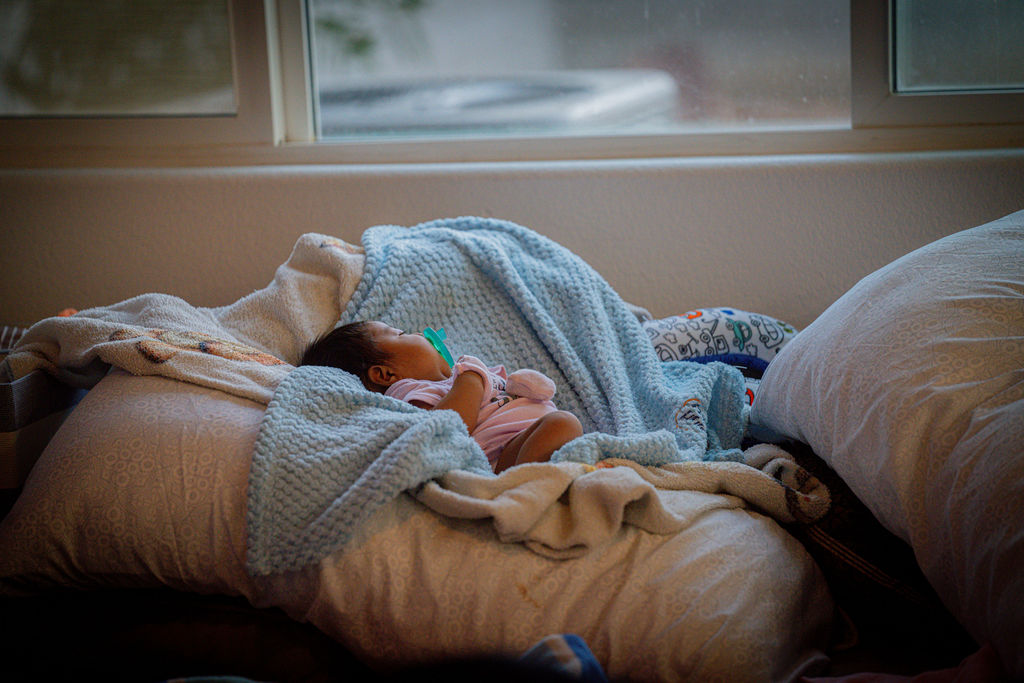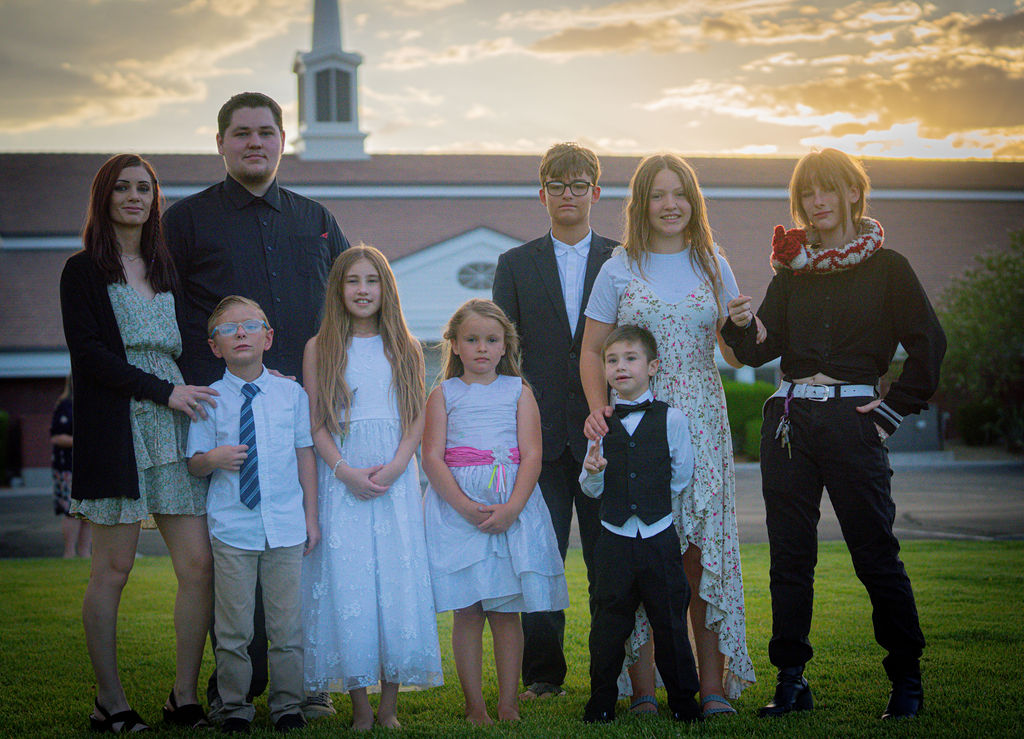

In a colorful tapestry of humanity, bi-racial families stand as living testaments to love that transcends boundaries. A bi-racial family is one where members hail from different racial backgrounds, creating a unique blend of cultures, traditions, and perspectives within their household.
Meet, my sister Monique Smalls, this is my amazing sister who has worked hard to have an amazing family here in her wonderful warm home. She decided to hire me for Family Photography in Las Vegas so we can get some photos of the kids. Really happy how’s these turned out.
These families embody the notion that diversity should not be seen as a division but rather as an opportunity for growth and understanding. Bi-racial families hold tremendous significance in today’s world, serving as ambassadors of acceptance and inclusivity.
They challenge the outdated notions of racial purity and highlight the beauty that lies in embracing differences. By embodying unity amidst diversity, these families exemplify the possibility of harmonious coexistence between various races and ethnicities.
Throughout history, societal attitudes towards bi-racial relationships have experienced dramatic shifts. What was once frowned upon or even outlawed in some societies has gradually evolved into acceptance and celebration in many parts of the world. Looking back at interracial relationships during periods of segregation and discrimination reveals immense challenges faced by individuals daring to defy societal norms.
Their love was met with hostility, prejudice, and even violence. However, their resilience paved the way for change.
The Civil Rights Movement in the United States during the mid-20th century played a crucial role in challenging systemic racism against bi-racial couples. Legal milestones such as Loving v. Virginia (1967) removed legal barriers to interracial marriage, setting an important precedent for acceptance.
As time progressed and societies became more interconnected through globalization and increased cultural exchange, attitudes towards bi-racial relationships continued to shift positively. Today’s society recognizes that love knows no color or ethnicity – it transcends these artificial boundaries.
The rise of social media platforms has also played a significant role in fostering awareness about bi-racial families. Stories of love and triumph over adversity are shared widely, promoting understanding and acceptance on a global scale.
It is essential to note that while progress has been made, challenges still persist. Prejudice and discrimination can rear their ugly heads in various forms, reminding us that there is still work to be done.
However, the journey of bi-racial families through history serves as a testament to the power of love and the potential for unity among diverse communities. In the next sections, we will delve deeper into the complexities surrounding bi-racial families – exploring identity formation, cultural dynamics, communication challenges, parenting experiences, extended family dynamics, societal perceptions through media representation, and the importance of celebrating diversity within these unique households.

Race is a complex and socially constructed concept that has played a significant role in shaping our society for centuries. It is important to understand that race is not biologically determined, but rather a social construct based on physical characteristics. Society has categorized individuals into distinct racial groups, often implying certain traits or behaviors associated with each group.
However, when it comes to bi-racial individuals, who have heritage from two different racial backgrounds, the concept of race becomes even more intricate. These individuals often find themselves straddling between two cultures and grappling with the question of where they fit in within society’s predetermined racial categories.
One of the primary challenges that individuals with mixed racial heritage face is the struggle to form a cohesive identity. Growing up with parents from different racial backgrounds can lead to conflicting cultural expectations and influences. This can make it difficult for them to fully identify with one particular culture or race.
Furthermore, society’s tendency to categorize people based on their appearance often leads to these individuals being subjected to stereotypes or assumptions about their ethnicity. This can create pressure on them to conform or choose one side of their heritage over the other.
The constant need to explain or justify their background can be emotionally draining and challenging for those seeking a sense of belonging. In addition, bi-racial individuals may experience internal conflicts as they reconcile their diverse backgrounds.
They may feel torn between embracing both sides equally or feeling like they don’t fully belong to either culture. Immersed in an environment where they are seen as “different,” finding acceptance and understanding becomes crucial in shaping their self-identity.
Navigating through these challenges requires open dialogue within families and communities while promoting an inclusive environment where diversity is celebrated rather than stifled. By acknowledging and appreciating the complexities of bi-racial identity, we can create a more inclusive society that values and supports individuals with mixed racial heritage.
Subheading: The Beauty of Blending Cultures In a bi-racial family, one of the most enriching aspects is the opportunity to celebrate and embrace multiple cultural backgrounds. This unique blend allows family members to experience a diverse range of customs, traditions, and values.
It creates a sense of inclusivity where everyone is encouraged to learn about and appreciate different cultures. Within the confines of a bi-racial family, each individual brings their own cultural heritage, creating a tapestry of diversity.
For example, meals can feature dishes from both sides: spicy Asian delicacies alongside comforting European classics. This amalgamation of flavors not only tantalizes taste buds but also creates an environment where culinary traditions from both cultures are respected and celebrated.
Moreover, embracing multiple cultural backgrounds within a bi-racial family extends beyond just food. It involves participating in festivals, holidays, and celebrations from both sides.
This opens doors to vibrant experiences such as lighting candles on Hanukkah or decorating colorful rangolis during Diwali. Immersing oneself in various cultural practices fosters understanding and respect for different beliefs, strengthening familial bonds in the process.

Subheading: The Delicate Dance of Cultural Integration While celebrating multiple cultural backgrounds can be immensely rewarding within a bi-racial family, it also comes with its fair share of challenges.
Balancing traditions, customs, and values from different cultures requires careful navigation that respects the uniqueness of each heritage while finding common ground. One challenge faced by families is deciding which customs or traditions take precedence during significant events or holidays.
For instance, should Christmas be celebrated with Santa Claus or with traditional Chinese lion dances? Negotiating these decisions requires open communication among family members so that everyone feels heard and valued.
Another challenge arises when members of a bi-racial family have different religious beliefs. Finding harmony between two or more religions can be complex, but it is essential to foster an environment where everyone’s faith is respected and supported.
This may involve creating personalized rituals or finding common values that transcend specific religious practices. Furthermore, bridging the gap between different cultural values can be an ongoing task within a bi-racial family.
For example, one culture may emphasize strict discipline and respect for elders, while the other might prioritize individuality and self-expression. It takes patience, understanding, and compromise to strike a balance that respects both sets of values.
Navigating cultural diversity within a bi-racial family offers incredible opportunities for growth and learning. By celebrating and embracing multiple cultural backgrounds, families create an environment where diversity flourishes and everyone feels valued.
However, this journey also comes with challenges in terms of balancing traditions, customs, and values from different cultures. Through open communication, respect for individual beliefs, and finding common ground, bi-racial families can successfully navigate these challenges while fostering harmonious cultural integration.
In bi-racial families, language can become a fascinating and essential aspect of daily life. With parents from different cultural backgrounds, it is common for family members to engage in code-switching – the practice of switching between languages or dialects depending on the situation.
This fluidity allows individuals to express themselves authentically while adapting to different social contexts. For instance, a child might seamlessly switch between English and Mandarin when conversing with their Chinese-American mother or English and Spanish when speaking with their Mexican-American father.
This linguistic versatility not only strengthens family bonds but also reinforces cultural identity. Multilingualism is a natural consequence of code-switching within bi-racial families.
Children raised in such households have remarkable opportunities for language acquisition as they are exposed to multiple languages from an early age. The ability to communicate fluently in various languages empowers individuals to connect with both sides of their heritage, enhancing their understanding of cultural nuances and facilitating meaningful connections with extended family members who may speak different languages.
Effective communication plays a vital role in bridging the cultural gaps that may arise within bi-racial families. It is important for family members not only to understand each other’s language but also grasp the underlying cultural context that shapes communication styles and expectations.
Active listening, empathy, and open-mindedness form the foundation for effective intercultural communication. In addition, being aware of potential barriers such as language proficiency disparities or differences in non-verbal cues can help foster better understanding among family members.
Encouraging open dialogue about these challenges allows individuals to express their needs and feelings while ensuring that miscommunication does not lead to unnecessary conflicts or misunderstandings. To facilitate effective communication, families can consider implementing practices such as regular family meetings or check-ins where everyone has a chance to share their thoughts and concerns.
Creating a safe space for open and honest communication encourages family members to express themselves freely, fostering stronger connections and a deeper appreciation for each other’s perspectives. By recognizing the power of effective communication, bi-racial families can overcome cultural barriers, build strong bonds, and create an environment where everyone feels heard, understood, and valued.
Communication dynamics in bi-racial families are rich and complex. Code-switching and multilingualism offer unique opportunities for individuals to embrace their diverse heritage and connect with multiple cultures.
Effective communication skills play a crucial role in bridging cultural gaps within the family unit by promoting understanding, empathy, and mutual respect. Embracing these dynamics ensures that bi-racial families thrive in an environment where languages are celebrated as tools for connection rather than barriers.
Raising children in a bi-racial family requires careful attention to nurturing their sense of self-identity. It is essential to help them embrace and celebrate all aspects of their racial heritage.
By acknowledging and validating their mixed background, parents can instill confidence and pride in their children’s unique cultural identity. Encouraging open discussions about race, heritage, and personal experiences will allow children to explore their own identities more deeply.

In a bi-racial family, there is an opportunity to expose children to multiple cultures and traditions. Parents can actively incorporate customs, stories, music, and food from both sides into their daily lives.
This exposure helps foster an appreciation for diversity while providing children with a broader understanding of the world around them. Engaging in cultural activities as a family builds strong connections between different backgrounds, reinforcing the idea that differences are something to be celebrated rather than feared.
Unfortunately, prejudice, discrimination, or racism might be encountered by bi-racial families at some point. It is crucial for parents to equip their children with coping mechanisms and resilience in facing these challenges head-on.
Teaching them about historical struggles against discrimination can empower them with knowledge and strength. Creating safe spaces within the family where open conversations about these issues are encouraged allows children to express their feelings without judgment.
Parents play a crucial role in fostering empathy within bi-racial families by emphasizing the importance of understanding others’ perspectives. Encouraging open-mindedness helps children appreciate different cultures beyond their own experiences while developing compassion towards those who may not share their background. It is vital for parents to teach their children the value of empathy, as it promotes inclusivity, acceptance, and a more harmonious society.
In a bi-racial family, there is an opportunity to bridge gaps between different communities. Parents can encourage their children to actively participate in events or activities that promote cultural exchange and understanding.
Engaging with diverse communities allows children to learn from others’ experiences and form connections beyond their immediate family unit. By cultivating strong relationships with people from different backgrounds, children develop a broader perspective of the world and become advocates for inclusivity and equality.
Raising children in a bi-racial family comes with unique challenges but also offers immense opportunities for personal growth, self-discovery, and cultural appreciation. By focusing on developing a strong sense of self-identity and cultural awareness within their children, parents can help them navigate any obstacles they may face due to prejudice or discrimination. Through nurturing empathy, understanding, and celebrating diversity both within the family unit and across communities, bi-racial families can play an integral role in fostering a more inclusive society for future generations.
In any family, the role of extended family members is often crucial, providing support, guidance, and a sense of belonging. In the context of bi-racial families, acceptance and support from extended family members can greatly impact the overall well-being and happiness of the family unit.
Ideally, when a bi-racial couple introduces their partner to their extended family, they hope for open minds and warm hearts. However, this isn’t always the case.
Acceptance from extended family members may vary depending on factors such as cultural background, generational gaps, personal biases, or even ignorance. Some relatives may readily embrace the diversity brought by a bi-racial relationship while others may struggle to understand or even reject it.
This can lead to tension within the family dynamic. Support from extended family members is particularly important during significant life events such as weddings or birth celebrations.
When these events occur within a bi-racial family context, it’s essential that all relatives come together to celebrate with love and respect for each other’s racial backgrounds. The presence of unconditional support fosters an environment where both partners feel valued and cherished.
When extended family members have different racial backgrounds within a bi-racial family setting, it can both enrich and complicate familial dynamics. On one hand, having diverse racial perspectives can broaden discussions at gatherings and provide opportunities for learning about different cultures. It allows for exposure to various traditions and customs that otherwise might not be experienced.
However, differences in racial backgrounds also have the potential to create tensions or misunderstandings within the family unit. Cultural clashes may arise due to contrasting values or expectations around topics such as child-rearing practices or social norms.
These differences can challenge existing traditions and require open-mindedness and compromise from all family members. It is crucial to foster an environment of mutual respect and understanding for the diverse racial backgrounds present within a bi-racial family.
Clear communication, empathy, and education about each other’s cultures can help bridge any gaps that may arise. This includes encouraging conversations that promote awareness, appreciation, and celebration of the various racial heritages within the extended family.
Extended family dynamics play a vital role in supporting the well-being of bi-racial families. Acceptance from extended family members is pivotal in creating an inclusive atmosphere where all individuals feel embraced for their diverse backgrounds.
Furthermore, navigating differences in racial backgrounds within an extended family requires open-mindedness and a willingness to learn from one another. By fostering acceptance and understanding, bi-racial families can thrive in their uniqueness while celebrating the diversity that binds them together.
Interracial relationships, characterized by love that transcends racial boundaries, can be a beautiful expression of diversity and understanding. However, it’s important to acknowledge the challenges these couples often encounter.
One significant challenge is the external scrutiny and prejudice they face from society. Despite progress in acceptance, some individuals still hold onto deep-seated biases and may judge or discriminate against interracial couples.
Another challenge stems from cultural differences within the relationship. Each partner brings their unique cultural background and upbringing, which can lead to clashes in traditions, values, and even communication styles.
Navigating these disparities requires open-mindedness, empathy, and a willingness to learn from one another. Moreover, family dynamics can pose difficulties in interracial relationships.
Family members may struggle to accept or understand their relative’s choice of partner due to ingrained biases or concerns about societal judgment. This can create tension within the extended family network and put strain on the couple’s relationship.
Another challenge arises from differing experiences with racism and discrimination. While both partners may face prejudice individually, they may encounter distinct forms of discrimination based on their respective racial backgrounds when together as a couple.
Addressing these experiences requires mutual support, understanding, and a commitment to fighting against racism as a team. Financial disparities between partners can also present challenges.
Socioeconomic factors often intersect with race due to historical inequalities that continue to impact certain communities more than others. These disparities can affect access to resources, opportunities for upward mobility, and financial stability within the relationship.
Despite the challenges mentioned above, interracial relationships offer numerous benefits not only for the individuals involved but also for society as a whole. Firstly, such relationships foster cultural exchange and broaden perspectives. When two people from different racial backgrounds come together, they have the opportunity to learn about and appreciate each other’s heritage, traditions, and customs.
This cultural exchange enriches their lives and promotes intercultural understanding. Interracial relationships also challenge societal norms and prejudices, promoting a more inclusive society.
By defying racial boundaries, these relationships serve as powerful reminders that love knows no color or ethnicity. They inspire others to question their own biases and challenge the stereotypical notions that can perpetuate discrimination.

Furthermore, studies have shown that children born into interracial families often develop unique strengths in navigating diversity and embracing multiculturalism. Growing up with parents from different racial backgrounds exposes them to multiple perspectives and helps them become more empathetic individuals who can contribute positively to an increasingly diverse world.
While interracial relationships may face challenges imposed by societal biases, cultural differences, family dynamics, discrimination experiences, and financial disparities – the benefits they bring to individuals involved and society as a whole outweigh these difficulties. These relationships foster understanding between different cultures, challenge stereotypes, promote inclusivity in society, and nurture children who are equipped with valuable skills for an interconnected world.
When it comes to bi-racial families, the beauty lies in the rich tapestry of cultures intertwined within. One beautiful way to honor this diversity is by incorporating celebrations from different cultures into family traditions. Imagine a Thanksgiving feast where alongside the classic turkey, you also have flavorful Indian curries or soulful Mexican tamales.
By blending different holiday customs and culinary delights, you create a unique experience that reflects the multifaceted nature of your bi-racial family. Incorporating diverse celebrations can be as simple as including decorations or symbols from various cultures during holidays.
For example, during Christmas, you could hang colorful Chinese lanterns alongside traditional ornaments or display African Kwanzaa candles on New Year’s Eve. These small gestures not only bring visual diversity but also serve as conversation starters for children to learn about their heritage and appreciate other cultures.
Children in bi-racial families have a wonderful opportunity to grow up with a broader understanding and appreciation for different cultural practices. Exposing them to these practices helps foster empathy, open-mindedness, and respect for diversity from an early age. Attending cultural events such as Chinese New Year parades or Diwali festivals can expose children to new sounds, tastes, and traditions that are outside their immediate experiences.
They may witness vibrant dances or hear enchanting music that sparks their curiosity about different parts of the world. Moreover, engaging children in hands-on activities related to diverse cultures can be both educational and enjoyable.
Encourage them to help prepare traditional dishes from each parent’s heritage or participate in craft workshops that teach traditional art techniques. By doing so, they will not only develop skills but also gain an appreciation for the cultural significance behind these practices.
It’s important to remember that exposing children to various cultural practices should be done in a sensitive and age-appropriate manner. It’s about instilling curiosity and respect, not forcing them into something they may not fully understand or appreciate at their young age.

Imagine a joyous scene where children in a bi-racial family gather for an egg hunt during Easter, but with a touch of vibrant diversity. Each colorful egg represents not only the traditional Easter celebration but also aspects of their diverse heritage.
It beautifully showcases how different cultural elements can come together harmoniously in celebrating life’s special moments. Incorporating diverse celebrations and exposing children to various cultural practices enables them to embrace their own identity while developing an appreciation for the world around them.
It fosters a sense of belonging, understanding, and respect that will stay with them throughout their lives. So, let your family traditions become a reflection of the beautiful amalgamation of cultures within your bi-racial family!
From early depictions of bi-racial individuals as exotic and otherworldly to the present-day efforts towards inclusivity, the portrayal of bi-racial characters in media has come a long way. In the past, bi-racial individuals were often relegated to supporting or token roles, reinforcing stereotypes and perpetuating misconceptions.
However, as society becomes more aware and progressive, we are witnessing a shift in how these characters are represented. In recent years, there has been a notable increase in TV shows and films featuring complex and nuanced bi-racial characters.
These portrayals seek to highlight the unique experiences of growing up with multiple cultural backgrounds. By showcasing authentic stories that delve into the challenges faced by bi-racial individuals, media is playing a crucial role in fostering understanding and empathy among viewers.
The power of media cannot be underestimated when it comes to shaping societal perceptions about race and ethnicity. The positive representation of bi-racial individuals has been instrumental in challenging preconceived notions and dismantling stereotypes. By portraying diverse narratives that go beyond racial binaries, media is actively promoting acceptance and celebrating the beauty of mixed heritage.
When audiences see multi-dimensional and relatable bi-racial characters on their screens or read about them in books, it opens up avenues for conversations about diversity and identity. This increased visibility helps create a more inclusive society where people from different racial backgrounds can feel valued for their unique experiences.
Moreover, by showcasing successful individuals who proudly embrace their mixed heritage, media is inspiring younger generations to be proud of who they are. Bi-racial representation not only validates their identities but also encourages them to explore their cultural roots while forging their own path.
The journey of bi-racial representation in media and popular culture has been one of progress and transformation. From being side characters to becoming protagonists, the evolution reflects a growing recognition of the importance of diverse voices and experiences.
Through authentic portrayals, media plays a vital role in shaping societal perceptions about bi-racial individuals. As we move forward, it is crucial for media creators to continue pushing boundaries and challenging stereotypes.
By amplifying diverse stories that reflect the rich tapestry of our society, we can foster greater understanding, empathy, and acceptance. Ultimately, the positive representation of bi-racial individuals in media has the power to create a more inclusive world where everyone’s unique heritage is celebrated.